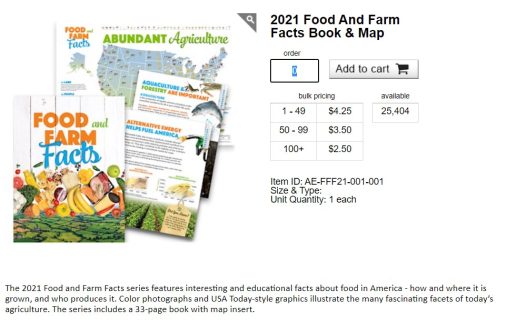 Fascinating facts about food in America – how and where it is grown and who produces it – are at your fingertips in a new resource produced by the American Farm Bureau Foundation for Agriculture. Order the new Food and Farm Facts book, map, pocket guide and related products in the series at Fb.org/store.
Fascinating facts about food in America – how and where it is grown and who produces it – are at your fingertips in a new resource produced by the American Farm Bureau Foundation for Agriculture. Order the new Food and Farm Facts book, map, pocket guide and related products in the series at Fb.org/store.
“With so many Americans interested in how our food system works, Food and Farm Facts is the perfect resource at the perfect time,” said Foundation Chairman Zippy Duvall, who also serves as president of the American Farm Bureau Federation.
Food and Farm Facts helps answer questions that learners of all ages may have, including “Where does our food come from and who grows it?” The 32-page, full-color book features updated facts and easy-to-read infographics about U.S. agriculture that can be used in a variety of ways to help increase agricultural literacy. The book would be a valuable resource in the classroom, at fairs and events, for student leadership organizations and when creating social media posts.
The book is organized by section (Consumers, Modern Farmers, Trade & Economics, Environment and Production). New in this edition of the book is information on how farmers are producing more on fewer acres and how they sustainably manage and preserve soil.
Copies of Food and Farm Facts may be purchased for $4.25 each (up to 49 copies). Price breaks are available for multi-copy purchases starting at 50: 50-99 copies, $3.50 each; 100 or more copies, $2.50 each. Each copy of the book includes a color “Abundant Agriculture” map poster depicting top agricultural products produced in every state. A pocket guide version of Food and Farm Facts (100 copies for $10) that features several popular infographics from the book is also available.
Additional Food and Farm Facts products created by the Foundation will be available later this fall. These include free classroom activity cards for grades 4-6 and a PowerPoint game for grades 7-12 developed using national learning standards and state “common core” standards that reflect the knowledge and skills young people need for success in college and careers.
